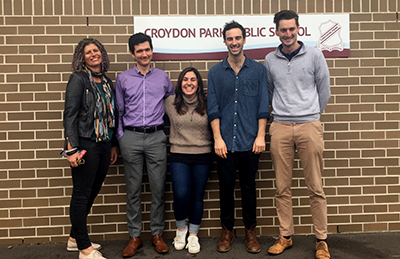|
Our Primary School Artist in Residence Program has just concluded at Croydon Park Primary School, once again culminating in a highly original student performance. |

NIDA Open Teaching Artist Duncan Ragg with Croydon Park teachers Sally Webeck, Tristan O’Neil, Maria Angoustinos and Eric Jewson.
Our Primary School Artist in Residence Program has just concluded at Croydon Park Primary School, once again culminating in a highly original student performance.
‘The students love the program and their general confidence has grown enormously, as has their scriptwriting, performing and oral skills,’ Stephen Costello, Assistant Principal, Croydon Park Public School.
Now in its seventh year, the Artist in Residence Program at Croydon Park has definitely found its rhythm, thanks to Teaching Artist and current Program Manager for Children and Young People Bronwyn Batchelor. Bronwyn designed and developed the program over the last few years in consultation with the teaching staff and students at Croydon Park.
The 10-week residency program focuses on literacy, creative writing, collaboration, devising and performance. This year, Duncan Ragg, one of our most experienced teaching artists had the pleasure of working with the students and teachers from Croydon Park. In addition to class work for the students, Duncan worked with the teaching staff to develop sustainable, integrated classroom outcomes through teacher professional development and paired written work designed to support the student activity.
Over 120 Stage Three students participated in the program. The final performance for family and friends was comprised of four original plays written and rehearsed throughout the term. They worked with the thematic provocation “The Far Side” and it was amazing to hear all the unique interpretations of this theme. There were portals, time travel and many different imaginary worlds; the resulting original works were complex, intelligent, humorous and poignant. The students developed so much confidence through the program and looked like they were having a wonderful time.
We spoke to Duncan Ragg, the NIDA Open Teaching Artist on the program.
What were the main benefits of the program for the students?
There were innumerable benefits for the students. They took complete ownership of the program, writing constantly for the first seven weeks. We went from fearing creative writing to being hungry for more writing time. They learned how to dive deep into the work, to find inspiration in the world around them, how to improvise and devise, how to structure a story, how to edit to find character and in the end, how to let our stories go when they’d reached their conclusion.
The other benefits were in performance: how to take up space on stage, how to structure a scene, how to use our voice, how to deal with nerves and how to read an audience and give them the show they didn’t know they wanted!
Most importantly, each student learned to play with each other, and to treat them as fellow actors and writers each with important voices to add.
What were the benefits of the program for teachers?
The teachers were given a clear pedagogical model to follow to get the best out of each student. We looked at a clear process from improvisation and writing exercises to devising methods and group dynamics to editing and directing scenes. We worked on approaches to individual students, focusing on how to get each student out of their shell and contribute significantly to the construction of each scene.
What were the highlights of the program for you?
The highlights of the program were getting to know each student and seeing their imagination in full flight. I loved seeing students lean into their fears: writing, performing, finding their voice in small groups. I loved that the students were enjoying the process so much that they volunteered to perform their scenes at a whole-school performance night, in front of 200 strangers!
Could you see any benefits on the wider school community?
Each week the writers went home to their families to gather information, objects, stories. They then shared these with the other writers. We got to know each other outside of the school parameters and it brought the community together. The students were excited for homework, because it meant connecting with their families and sharing these parts of themselves with other students. Teachers wanted to come into the classes to see our works in progress, and to learn this process. We saw so many of the students coming out of their shell and taking charge of their own learning.
What was a highlight of the performance for you?
The highlights of the performance was seeing the students fall so in love with performing that they let go of their rehearsed movement and started to play with the audience. We were rolling with laughter.
Contact NIDA at schools@nida.edu.au for more information.

